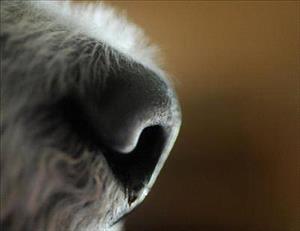It would be really cool to have a dog hanging out at the entrance of busy places, picking out infected people
Dog nose profile

Photo by Karen James
I’ve had countless questions about the potential for scent detection dogs to be useful for COVID-19 surveillance. It’s an interesting idea, but it’s dependent on COVID-19-infected people producing some volatile compound detectable by the dogs that uninfected people do not. (The virus itself is not likely to have a detectable odour.)
A recent pre-print paper on bioRxiv provides a rambling description of a pilot study about the potential for dogs to sniff out COVID-19 in people based on their armpit sweat. This one can probably be filed under the “not likely to ever be published in a journal, but an interesting story” category. (It may also be another paper in the “let’s get something online first, who cares about the depth and editing” category. Sixty-one authors is a bit extreme too, but I digress.) As I’ve said before, pre-prints can be useful, but there has to be at least a modicum of effort…
Anyway, they collected armpit sweat samples from people with COVID-19 and patients without signs of COVID.
They used 18 dogs that had been trained for explosive detection, search and rescue, and colon cancer detection, but their table also lists an arson detection dog. Further, they say that “We did not decide to work with drug detection dogs as there is always a possibility that COVID-19 positive or negative people use prohibited substances that would let catabolites be excreted by the axillary sweat.” And yet, their table lists a drug detection dog.
After training, the dogs were tested to see if they could differentiate sweat samples from COVID-19 patients in scent boxes, from the samples from the non-infected patients.
- Three of the 18 dogs flunked out of COVID-19 detection school as they were “unable to adapt to an olfactive search on a line of sample.”
- Eight others were removed because they were “late in their testing period due to this necessary basic ‘retraining’.” I’m not really sure what that means. I guess they weren’t completely kicked out of school but had to repeat the year, and no one wanted to wait to rush out the pre-print.
The authors say that left 8 dogs whose results they used for the analysis; however, my math says that 18-3-8=7, not 8.
Numbers aside, results were interesting, as the remaining dogs seemed to have fairly high detection rates (84-100%).
It’s hard to say what this means and whether it’s relevant. I guess it means that there’s potential for some dogs, but you have to find the right dogs, and train them. The authors make a fair point that they were looking at effective dogs, not whether it worked in the whole dog population.
Is this of any use?
It’s hard to say. They tested samples from people with overt COVID-19 disease, and that’s likely not very relevant. If someone has signs of COVID-19, we want to treat them like they have COVID-19 at least until they are definitely tested, regardless of what the dog thinks. Where this would be more useful is for detecting asymptomatically infected people, in which case the dog might provide an early warning of infection. The downside is that it requires a dog and a person to be in close proximity to the patient being screened. Dogs are low (but not no) risk for picking up SARS-CoV-2, but there’s also reasonable concern about handlers. The practical nature of this is also questionable. The study mentions that armpit sweat is “easy and safe to collect" but if the “test” relies on people taking samples of their own armpit sweat, it’s no longer a quick, easy detection method. It’s more appealing if the dog can, for example, be used to screen people coming into a building or workplace.
The authors have a few excuses for some of the false negative results, which seem to be a bit of a stretch, or indicate potential issues applying this to a real world situation (e.g. distraction by a “too zealous television team”). Some other discussion points are a bit hard to follow. They attributed false positives to two male dogs and a young woman that “had been sampled during her fertile period”… they’d better sort that problem out since that’s a reasonably common subset of the population. The paper’s discussion devolves considerably from there: “In Shakespeare’s day, a woman in her fertile period used to hold a peeled apple under her arm until the fruit became saturated with her armpit scent ; then she presented this “love apple” to her lover to inhale in order to provoke his sexual excitation. Pheromones are defined as substances produced by an animal which conveys information to other individuals by olfactory means. And in such a situation androsterone and molecules like benzoate derivates, excreted in axillary sweat, enhance sexual attraction by men toward women near the end of follicular phase of the menstrual cycle when fertility is at highest.”
Overall, it’s an interesting pilot study that shows more study might be warranted. In particular, it’s important to figure out whether dogs can be good detectors of COVID-19 infected people in situations like busy, high risk places in the community. Criticisms aside, it would be really cool to have a dog hanging out at the entrance of busy places, picking out infected people, to help curb further spread of SARS-CoV-2 in the community.
Reprinted with permission from Worms and Germs Blog